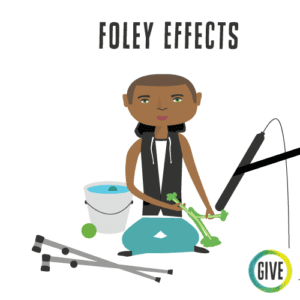制作 Foley 声音
贡献者 劳拉·博格沃特
![]()
![]()
说明
This activity helps students discover how the sounds used in movies and animations are created behind the scenes, by practicing making sounds with various objects and matching them with the actors’ actions and moods. Students will have a chance to become actors, Foley artists, and audience members, working in collaboration to build a positive community in the classroom.
路线
- Introduce the class to Foley—Foley effects are the sounds that are added to a movie or a play. They help increase the sound quality and help tell a specific story.

- Have students explore different Foley objects—what sounds do they make?
- “Today we are going to make the sounds of different characters moving across the stage. Some characters might be realistic and their footsteps might sound like shoes walking on the floor; some characters might be silly and their footsteps sound a little wacky (e.g., the SpongeBob SquarePants walking noise); and some characters might slither or crawl across the space.”
- Have one actor (maybe a Classroom Professional) move across the stage/space/screen in a specific way. “How did the actor move? Were their movements small/big? Light/heavy? Realistic/silly? Does anyone have a sound effect that matches that character?”
- The actor will cross the space again, this time with the Foley artist matching their movements with sound. “Make sure to pay attention—the sound should happen at the exact moment their foot or other body part hits the floor.”
- Try working backward! Have one of your Foley artists play a sound and have that sound inspire the actor to create a way of moving that matches the Foley.
- 反射:
- “Did you like being an actor or a Foley artist better? Why?”
- “What were the important skills we needed in each of the roles?”
- Extensions: You could have a puppet move across the space and match their footsteps, or have the actor “walk” with different parts of their body (e.g., fingers, elbows, etc.).
过渡到活动
手持隐藏的吱吱声或其他拟音物体进入空间,并让脚步声与吱吱声相匹配。表现得非常困惑,并询问全班是否听到了那种噪音。发现您的拟音对象。
退出活动
“What Foley sound could we use for someone falling asleep/snoring? Let’s all try. Relax. Sleep. Okay, wake up! (Bringggggg!) It’s time to get back to class.”
课堂布置
Audience/playing space.
支持/自适应材料/工具
- For those with sound sensitivities, you can have headphones available to wear during the game or find a seat for them that is further from the Foley artists.
- Have lots of different kinds of Foley that are manipulated in different ways—squeeze, hit, scrunch, slap. Have options that require both fine motor and gross motor skills.
- 如果您真的很喜欢并且有麦克风,请放置 Foley 艺术家的麦克风,以便他们可以使用更广泛的对象来制作声音效果。
- Visual Vocabulary Cards (downloadable).
- Video examples to learn about Foley sounds:
课堂专业人员可能扮演的角色
- Model 100% participation—encourage a Classroom Professional to volunteer to be the first actor and invite them to be as silly as they can. Their willingness to take a risk will encourage the students to do so as well.
- Side-coach Foley artists: “Got your object ready? Okay, they are taking the first step—squeeze!”
远程教学的调整
![]()
这是一款适合在线课程的好游戏,有些学生想打开他们的相机(他们可以是演员!),有些学生想关闭他们的相机(他们可以是拟音师!)。来上课时,准备一些学生可能在他们家中用来创造声音的物品的例子。演员需要确保尽可能多的身体在画面中,尤其是当他们走过他们的空间时。确保所有观众都处于静音状态,以便可以听到拟音艺术家的声音。
